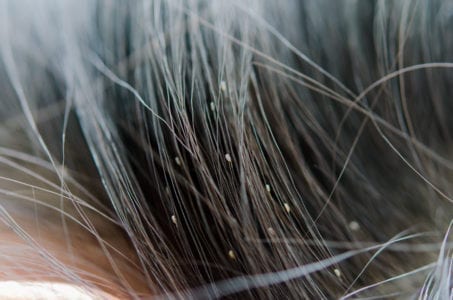
When kids head back to school, they sometimes bring home more than just homework and dirty clothes. This is the time of year when we start to see a rise in cases of lice in children. According to the Centers for Disease Control (CDC), between 6 and 12 million kids between the ages of 3 and 11 are infested with them each year.
Lice can spread easily from one child to another, which is why now is the time to pay close attention if your child complains of an itchy scalp or if the school sends out an email notifying you of an outbreak.
How Do I Know If My Child Has Lice:
The typical symptom a child experiences is a very itchy head, but this is not always the case. In some instances, a child will have them but not have an itchy scalp.
They are very hard to find because the bugs are very small, avoid light and are very fast. The best place to find them is at the back of your child’s neck at the hairline or around the ears. Finding nits and eggs in your child’s scalp suggests a diagnosis of lice but does not confirm it.
Anybody Can Get Them:
Kids of all ages can get lice and so can adults. For many incorrect reasons, there is a lot of embarrassment around it.
I want to emphasize that getting them has nothing to do with your child’s hygiene or your parenting. Anybody can get them no matter how often she or he showers or tries to avoid it.
Lice are very contagious and are spread mainly by direct contact. They can’t jump to another person, but they can crawl. You’ve probably heard that they can be spread by sharing hats or combs, but the main way it’s transferred from one child to another is by direct contact.
If you have a child with lice, you should check the rest of your family as well. If the child with lice shares a bed with a brother or sister, I recommend treating the other child whether or not they show symptoms just to be safe.
My Child Has Lice, Now What:
If your child has them, you don’t have to take them to the pediatrician right away. There are a lot of over-the-counter medications you can start with. You can also use home remedies such as mayonnaise.
These treatments usually do a good job of killing any lice or eggs in the scalp, but with some products, you may need to do a re-treatment a week later.
If mayonnaise or over-the-counter medication doesn’t work, you should consult your pediatrician to determine if a prescription is needed.
Whether it’s a home-remedy or a prescription, the goal is the same— kill the live lice and the eggs before they hatch.
When Can My Child Go Back to School:

Kids with lice do not need to immediately leave school for the day. They can spend the rest of the day at school, have treatment at night and go back to school the next day.
Some schools have a policy that says a child can’t have any nits in their hair before returning to school. Nits are simply the white shells of empty lice eggs that do not have any live lice in them. For that reason, kids should be able to go back to school even if nits are present.
After Lice:
Any clothes or bed linens that have been in contact with the child within two days of finding them should be machine washed with hot water and dried. Combs and brushes should be soaked in hot water for 5-10 minutes.
Other things like furniture, carpet and car seats don’t necessarily need to be washed, but they should be vacuumed. If you have items like stuffed animals that can’t be washed, you can put those items in plastic bags for a couple weeks to kill any lice that may have gotten on them.








